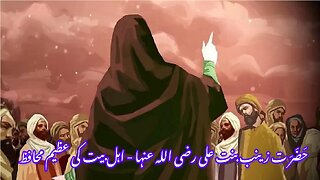Premium Only Content

Mian Muhammad Bakhsh मियां मुहम्मद बख्श میاں محمد بخش کی سوانح حیات اور ان کے مزار کی تاریخ
@islamichistory813 mianmuhammadbakhsh #sufisaint #culturalheritage #biography #islamicmysticism #islamicphilosophy #shrine #historicalfigures
Biography of Mian Muhammad Bakhsh and the history of his shrine
Dekhti Aankhooon aur sountay kaanoon ko Asslamoalaikum, sisters, brothers friends and elders, in informative series videos of Islamic ascolars, sufisaints, cultural heritages, islamic philosophys, islamic mysticisms and historical figures. today we are describing biography of Mian Muhammad Bakhsh and the history of his shrine.
Mian Muhammad Bakhsh was a Punjabi Muslim poet from Khari Sharif, Kashmir. He wrote 18 books during his lifetime of 77 years, especially remembered for his romantic epic poem, "Saiful Maluk" in which he wrote the traditional Arabic story of Prince Saiful Maluk into a poem. He also wrote the romantic tragedy, "Mirza Sahiban". Most of his work is in Punjabi, with the exception of the book "Yari", written in Persian.
Bakhsh is revered throughout the Punjab, Hazara and Kashmir. He is regarded as the bridge between medieval and early-modern Punjabi literature.
Bakhsh was born in c.?1830 in Khari Sharif, Kashmir (present-day Azad Jammu and Kashmir, Pakistan) during the Sikh rule, into a Gujjar Punjabi family of the Paswal clan with roots in Gujrat, Punjab (present-day Punjab, Pakistan). There is considerable disagreement about his year of birth. Mahb?b 'Al? Faqir Qadiri, in a biography printed as an appendix to the text of Sayful Mul?k gives the date as 1246 AH (1830 AD), a date also followed by the Sh?hk?r Islami Encyclopedia; 1830 and 1843 are suggested in other works. Mian Muhammad Bakhsh himself states in his magnum opus, Sayful Mul?k, that he completed the work in the month of Ramadan, 1279 AH (1863 AD), and that he was then thirty-three years of age. Hence, he must have been born in 1829 or 1830.
He was brought up in a very religious environment, and received his early education at home. He was later sent with his elder brother, Mian Bahaval, to the nearby village of Samwal Sharif to study religious sciences, especially the science of Hadith in the madrassah of H?fiz Muhammad 'Al?. His teacher was Hafiz Ghulam Hussain. H?fiz Muhammad 'Al? had a brother, H?fiz N?sir, who was a majzub, and had renounced worldly matters; this dervish resided at that time in the mosque at Samwal Shar?f. From childhood M??n Muhammad had exhibited a penchant for poetry, and was especially fond of reading Y?suf ? Zulaikha by Nur ad-Din Abd ar-Rahman Jami. During his time at the madrassah, Hafiz Nasir would often beg him to sing some lines from Jami's poetry, and upon hearing it so expertly rendered would invariably fall into a state of spiritual intoxication.
Mian Muhammad was still only fifteen years old when his father, falling seriously ill, and realizing that he was on his deathbed, called all his students and local notaries to see him. Mian Shamsuddin told his visitors that it was his duty to pass on the spiritual lineage that he had received through his family from Pir-e Shah Ghazi Qalandar Damriyan Wali Sarkar; he pointed to his own son, Mian Muhammad, and told those assembled that he could find nobody more suitable than he to whom he might award this privilege. Everybody agreed, the young man's reputation had already spread far and wide. Mian Muhammad, however, spoke up and disagreed, saying that he could not bear to stand by and allow his elder brother Bahavul to be deprived of the honour. The old man was filled with so much love for his son that he stood up and leaving his bed grasped his son by the arms; he led him to one corner and made him face the approximate direction of Baghdad, and then he addressed the founder of their Sufi Order, Shaikh Abdul Qadir Gilani, presenting his son to him as his spiritual successor. Shortly after this incident his father died. M??n Muhammad continued to reside in his family home for a further four years, then at the age of nineteen he moved into the khanqah, where he remained for the rest of his life. Both his brothers combined both religion and worldly affairs in their lives, but he was only interested in spirituality, and never married unlike them.
Saif ul Maluk (1863) is considered his masterpiece. In its ending verses, Mian Muhammad Bakhsh listed major genres of Punjabi poetry and his predecessor Punjabi poets:
The land of Punjab has had many poets full of wisdom, who have composed brilliant kafis, bara?mahs, doh??s and baits. Some have composed and written books, qissas and risalas. Where now has that company gone, Muhammad Look and take careful stock.
First is Shaikh Farid Shakarganj, true knower and possessor of sainthood. Every utterance of his tongue is a guide on the true path.
Then there was a Sultan Bahu, a special hero in the cause of truth. The doh?as which he uttered shine out in both worlds.
On listening to the kafis of Bullhe Shah, inner unbelief is broken. He swims about in the ocean of Oneness.
Once he had advanced a little along the Sufi way, he became more and more interested in composing poetry, and one of the first things he penned was a qasidah (quatrain) in praise of his spiritual guide. Initially he preferred to write siharfis and duhras, but then he advanced to composing stories in verse. His poetry is written in a mixed language composed of the Majhi, Potohari and Hindko dialects of Punjabi, and utilizes a rich vocabulary of Persian and Arabic loan-words. Mian Muhammad Bakhsh, in his lifetime, contributed his great mystic thought in the language of the masses – Punjabi language which was also his mother tongue.
His works include: Siharfi, Sohni Mahiwal, Tuhfah-e Miran, Tuhfah-e- Rasuliyah, Shirin Farhad, Mirza Sahiban, Sakhi Khavass Khan, Shah Mansur, Gulzar-e Faqir, Hidayatul Muslimin, Panj Ganj, Masnavi-e N?rang-e ‘Ishq. He also wrote a commentary on the Arabic Qasidat al-Burda of al-Busiri and his most famous work, entitled Safarul ‘Ishq (Journey of Love), but better known as Saif ul Maluk.
Despite the fact that he had essentially been made a khal?fah of his father, he realized that he still needed to make a formal pledge of allegiance or bay'ah to a Sufi master. Having completed his formal education he began to travel, seeking out deserted locations where he would busy himself in prayer and spiritual practices, shunning the company of his fellow-men. He took the Sufi pledge of allegiance or bay'ah with Ghulam Muhammad, who was the khalifah of Baba Bad?h Sh?h Abd?l, the khalifah of Haji Bagasher (of Dark?l? Mamuri Sharif, near Kallar Syedan District Rawalpindi), the khalifah again of Dumriyan Wali Sarkar. He is also said to have travelled for a while to Srinagar, where he benefitted greatly from Shaikh Ahmad Vali.
He died on the 7th day of the Islamic month of Dhu al-Hijjah 1324 AH (1907 AD), and was buried in Khari Sharif, not far away from his spiritual great great grandfather, Damriyan Wali Sarkar. To this day many people visit his tomb with the intention of receiving spiritual blessings.
Shrine of Mian Muhammad Bakhsh at Khari Sharif, Pakistan.
In February 2016, rich tributes were paid to Mian Muhammad Bakhsh at a literary seminar held at Allama Iqbal Open University, Islamabad, Pakistan. Speakers at the seminar included scholar Fateh Muhammad Malik. He said that Mian Muhammad Bakhsh, through his poetry, spread the message of mutual harmony and brotherhood of mankind. He added that the young generation should seek aspirations from the national heroes and eminent literary personalities like him. Mian Muhammad Bakhsh serves as a guiding force to develop a happy and successful life.
With this, we seek your permission until tomorrow, tomorrow we will describe the biography of Mir Sayyid Ali Hamadani and the history of his Shrine. Allah Hafiz.
=============================
-
 13:31
13:31
ISLAMIC HISTORY
1 day agoZaynab bint Ali (RA) Defender of Ahl al Bayt زینب بنت علی رضی اللہ عنہا - اہل بیت کی عظیم محافظ
8 -
 DVR
DVR
IsaiahLCarter
11 hours ago $2.89 earnedAntifa Gets WRECKED. || APOSTATE RADIO 030 (Guests: Joel W. Berry, Josie the Redheaded Libertarian)
28.8K -
 LIVE
LIVE
CassaiyanGaming
2 hours agoArena Breakout: Infinite Dawg
108 watching -
 2:24:32
2:24:32
vivafrei
12 hours agoEp. 284: Ostrich Crisis Continues! Kirk Updates! Fed-Surrection Confirmed? Comey Indicted! AND MORE!
112K168 -
 LIVE
LIVE
Cewpins
2 hours agoSunday Sesh!🔥Rumble Giveaway Tonight!🍃420💨!MJ !giveaway
147 watching -
 3:03:11
3:03:11
Conductor_Jackson
4 hours agoLet’s Play BioShock Infinite Burial at Sea Episode 2!
7.53K -
 DVR
DVR
EricJohnPizzaArtist
6 days agoAwesome Sauce PIZZA ART LIVE Ep. #63: Charlie Sheen
35.9K4 -
 LIVE
LIVE
THOUGHTCAST With Jeff D.
2 hours agoTHOUGHTCAST Jeff and Keegan play Left 4 Dead 2. Classic games
34 watching -
 2:43:09
2:43:09
putther
6 hours ago $0.25 earned⭐ GTA ONLINE BOUNTIES THEN GTA IV ❗
60.2K4 -
 6:31:38
6:31:38
GritsGG
9 hours agoQuad Win Streaks!🫡 Most Wins in WORLD! 3600+
64.9K1